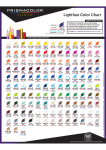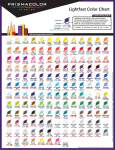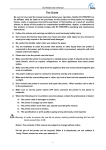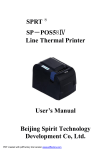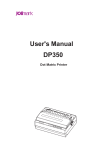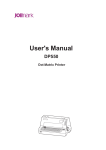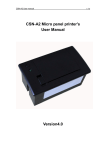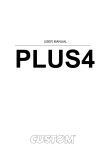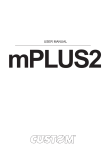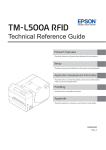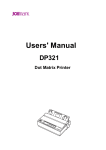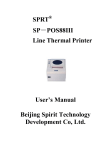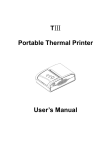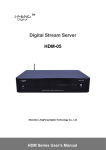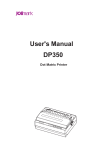Download TP820 User`s Manual (V1.4)
Transcript
User's Manual
TP820 Series
Thermal Receipt Printer
TP820 User’s Manual
Declare
About Trademark
Corporation names and product names are the registered trademarks or commodity
names of the corporation.
* EPSON is a registered trademark of Seiko Epson Corporation.
* ESC/ POS is a registered trademark of Seiko Epson Corporation.
* Windows is a registered trademark of Microsoft Corporation.
-i-
TP820 User’s Manual
Important Safety Instructions
Read all of these instructions carefully and thoroughly and save them for later reference. The
unauthorized operation would lead to malfunction or accident. Manufacturers have no
responsibilities for the problems which are led by misoperations.
1.
Follow all warnings and instructions in the manual as well as marked on the product.
2.
Don’t touch the thermal print head with your hand at any moment to avoid the thermal head damaged.
3.
Be careful the manual cutter when you are installing the paper.
4.
Unplug this product from the power outlet before cleaning. Do not use liquid or aerosol cleaners. Use a
damp cloth for cleaning.
5.
Please don’t use the printer near water.
6.
Do not place this product on an unstable cart, stand or table. The product may fall, causing serious
damage to you or the product.
7.
Slots and opening on the cabinet and the back or bottom are provided for ventilation. To ensure reliable
operation of the product and to protect it from overheating, do not block or cover these openings. The
openings should never be blocked by placing the product on a bed, sofa, rug or other similar surface.
This product should not be placed in a built-in installation unless proper ventilation is provided.
8.
This product should never be placed near or over a radiator or heat origin, and should avoid of direct
sunshine.
9.
Do not locate this product where the cord will be walked on. When the cord or the plug is mangled,
please stop using and get a new one replaced. Make sure the old one is far away from the printer, so it
can avoid someone who does not know the inside story getting damage.
10. Be sure to use the specified power source. Connection to an improper power source may cause fire or
shock.
11. Do not use in locations subject to high humidity or dust levels. Excessive humidity and dust may cause
equipment damage or fire.
12. Never push objects of any kind into this product though cabinet slots as they may touch dangerous
voltage dots or short out parts.
13. Don’t remove the printer’s out-cover and repair the printer. When needed, call or take it to the
professional.
14. If water or other liquid spills into this equipment, unplug the power cord immediately, and then contact
your dealer or a service center for advice.
15. To ensure safety, please unplug this product prior to leaving it unused for an extended period. The wall
outlet you plan to connect to should be nearby and unobstructed.
16. This device complies with Part 15 of the FCC Rules.
Operation is subject to the following two conditions:
(1) This device may not cause harmful interference.
(2) This device must accept any interference received, including interference that may cause
undesired operation.
The manufacturer is not responsible for any radio or TV interference caused by unauthorized
modifications to this equipment. Such modifications could void the user's authority to operate the
equipment.
17. Unplug this product from the wall outlet and refer servicing to qualified service personnel under the
following conditions:
a)
When the power cord or plug is damaged or frayed.
- ii -
TP820 User’s Manual
b)
If liquid has been spilt into the product.
c)
If the product has been exposed to rain or water.
d)
If the product does not operate normally when the operating instructions are followed.
e)
If the product has been dropped or the cabinet has been damaged.
f)
If the product exhibits a distinct change in performance, it indicates a need for service.
Warning: In order to ensure the printer life, strictly prohibit printing full line full black exceeding
2 CM.
Notice: The contents of this manual are subject to change without notice.
*All the parts of the printer can be recycled. When it is abandoned, we can call it back freely.
Please contact us when you abandon it.
- iii -
TP820 User’s Manual
Table of Contents
Declare..........................................................................................................................................................i
Important Safety Instructions ....................................................................................................................ii
Chapter 1 Overview ....................................................................................................................................1
1.1 Features ..............................................................................................................................................1
1.2 Product Model Description ..................................................................................................................1
1.3 Main Parts of the Printer......................................................................................................................1
Chapter 2 Installing the Printer..................................................................................................................3
2.1 Unpacking and Checking ....................................................................................................................3
2.2 Removing the Protective Materials......................................................................................................3
2.3 Connecting to Your Computer or Other Equipment .............................................................................3
2.3.1 Connecting the Cash Drawer Cable .............................................................................................3
2.3.2 Connecting the Parallel Cable ......................................................................................................4
2.3.3 Connecting the USB Cable...........................................................................................................4
2.3.4 Connecting the Serial Cable .........................................................................................................4
2.3.5 Connecting the Ethernet Cable.....................................................................................................5
2.4 Connecting the Power Cord ................................................................................................................5
2.5 Installing the Print Driver and Selecting the Cutter..............................................................................6
2.6 Installing Bluetooth Interface Driver ....................................................................................................9
2.7 Ethernet Settings............................................................................................................................... 12
2.7.1 Connecting Printer...................................................................................................................... 12
2.7.2 Setting IP Address ...................................................................................................................... 12
2.8 Wi-Fi Setting...................................................................................................................................... 15
2.8.1 Connect to the Printer, Run the WiFiConfig Software .................................................................15
2.8.2 Set Wi-Fi Parameters ................................................................................................................. 17
2.8.3 Checking Wi-Fi Parameters........................................................................................................ 18
2.8.4 Recover the Default Setting........................................................................................................ 18
2.9 Installing Printer Network Driver........................................................................................................ 19
Chapter 3 Control Panel........................................................................................................................... 26
3.1 Control Panel .................................................................................................................................... 26
3.1.1 Indicator light .............................................................................................................................. 26
3.1.2 Key ............................................................................................................................................. 26
3.2 Self-Printing....................................................................................................................................... 26
3.3 Hex Dump Printing ............................................................................................................................ 27
3.4 Restoring Factory Printer Settings .................................................................................................... 27
3.5 Setting Slip Stitch .............................................................................................................................. 27
3.6 Online-aptitude Parameter Settings .................................................................................................. 27
Chapter 4 Installing and Replacing the Roll Paper ................................................................................ 29
4.1 Paper Installation Steps..................................................................................................................... 29
Chapter 5 Specification ............................................................................................................................ 31
5.1 General Specification ........................................................................................................................ 31
- iv -
TP820 User’s Manual
5.2 Interface Specifications ..................................................................................................................... 32
5.2.1 Cash Drawer Interface................................................................................................................ 32
5.2.2 Parallel Interface......................................................................................................................... 33
5.2.3 USB Interface ............................................................................................................................. 34
5.2.4 Serial Interface ........................................................................................................................... 34
5.2.5 Ethernet Interface ....................................................................................................................... 35
5.2.6 Power Supply Inlet...................................................................................................................... 35
Chapter6 Troubleshooting and Maintenance ......................................................................................... 36
6.1 Maintenance...................................................................................................................................... 36
6.2 Error Message on the Control Panel ................................................................................................. 36
6.3 Auto-Cutter Jammed or Error ............................................................................................................ 36
Chapter 7 Control Commands ................................................................................................................. 38
7.1 General ............................................................................................................................................. 38
7.2 Explanation of Terms......................................................................................................................... 38
Appendix Commands List ....................................................................................................................... 51
-v-
TP820 User’s Manual
Chapter 1 Overview
1.1 Features
TP820 printer is a high-speed mini thermal printer. It is a high-quality, high-reliability and low-noise
POS printer without ribbon. It’s small, operated easily and can be widely used in ECR, PC-POS and
BANK POS for printing a variety of receipts.
1.2 Product Model Description
In order to fulfill different requirements and operating circumstance, manufacturer develops TP820
series products which are high-speed thermal mini-printers.
According to different data ports (interfaces), TP820 series can be classified into different models:
TP820, TP820U, TP820US, TP820UE, TP820UB and TP820UW.
TP820 series printer is equipped with an auto cutter which has two options for the consumer to select:
partial cutter can only cut the paper with one point left while full cutter cuts the paper fully.
Interface:
TP820 series products are configured with a cash drawer interface, you can choose one of the
following data interfaces when purchasing this product:
Model
Interface
TP820
Parallel interface
TP820U
USB interface
TP820US
USB interface + Serial interface
TP820UE
USB interface + Ethernet interface
TP820UB
USB interface + Bluetooth
TP820UW
USB interface + Wi-Fi
Note: Please contact the local dealer to change the interface with added expense if needed.
1.3 Main Parts of the Printer
Power Indicator
Upper Cover
Error Indicator
Cover-open Button
Paper out Indicator
Manual Cutter
FEED Key
Power Switch
Front Cover
Figure 1-1 Main parts of the printer
-1-
TP820 User’s Manual
Data Interface
Cash Drawer Interface
Power Supply Inlet
Figure 1-2 Back interfaces of the printer
Note: According to the specific interface standards
-2-
TP820 User’s Manual
Chapter 2 Installing the Printer
2.1 Unpacking and Checking
Check the following items in the package, if any of these items is missing, please contact your dealer.
Power Cord
Printer
Driver CD
(Including User's Manual and Driver)
Interface Cable
AC Adapter
Facility User’s Guide
Figure 2-1 Packing list
2.2 Removing the Protective Materials
1. Open the packing box, take out the printer.
2. Save all the original packing materials so that they can be used when transporting the printer.
2.3 Connecting to Your Computer or Other Equipment
The printer is configured with a cash drawer interface and one data interface (Parallel interface, USB
interface, Serial + USB interface, Ethernet + USB interface, USB interface + Bluetooth or USB interface
+ Wi-Fi). (According to specific interface standards) Connect the printer to your computer with the
correct cable.
Note: Before connecting or disconnecting the cash drawer cable, parallel cable or serial cable,
make sure that the power of the printer is turned off. Also make sure the power cable plug
is disconnected from the AC outlet. Or else it may damage the printer.
2.3.1 Connecting the Cash Drawer Cable
Turn off the printer and plug one end of the cash drawer cable into the cash drawer interface of the
printer and the other end connects to cash drawer, as shown in Figure 2-2.
Cash Drawer Interface
Cash Drawer Cable
Figure 2-2 Connecting the cash drawer cable
-3-
TP820 User’s Manual
Caution: Please use the appropriate cash drawer. Manufacturer will not honor warranty when using
unauthorized cash drawer.
2.3.2 Connecting the Parallel Cable
1. Make sure the computer and the printer are both turned off, connect the parallel cable to the
connector of the printer, and then fasten the wire clips as shown in Figure 2-3.
Wire Clips
Parallel Interface
Parallel Cable
Figure 2-3 Connecting the parallel cable
2. Connect the other end of the cable to the computer. Tighten the screws.
2.3.3 Connecting the USB Cable
1. Plug the USB cable A end (flat shape) into the computer's USB interface.
2. Plug the USB cable B end (square shape) into the printer's USB interface as shown in Figure 2-4.
Note: Please don’t impact the plug after connecting USB cable.
USB Interface
USB Cable
Figure 2-4 Connecting the USB cable
2.3.4 Connecting the Serial Cable
1. Make sure the computer and the printer are both turned off, connect the serial cable to the connector
of the printer. Tighten the screws as shown in Figure 2-5.
-4-
TP820 User’s Manual
Screws
Serial Cable
Serial Interface
Figure 2-5 Connecting the serial cable
2. Connect the other end of the cable to the computer’s serial interface and tighten the screws.
2.3.5 Connecting the Ethernet Cable
1. Plug the crystal end of the Ethernet cable (RJ-45) into the printer's Ethernet interface as shown in
Figure 2-6.
2. Plug the other end of the Ethernet cable into the LAN’s entrance.
Ethernet Cable
Ethernet Interface
Figure 2-6 Connecting the Ethernet cable
Note: Please refer to the user’s manual for the detailed instructions of network settings.
2.4 Connecting the Power Cord
1. Make sure the printer is turned off. (O mark on the power switch is pressed down)
2. Make sure the voltage of the electrical outlet matches that of the AC adapter.
3. Plug the AC adapter to the printer’s power supply inlet.
4. Plug one end of power cord into the AC adapter, and then plug the other of power cord into the
grounded electrical outlet.
Note: 1. If the rated voltage doesn’t match the outlet voltage, contact your dealer for
assistance. Do not plug in the power cord.
2. Please use the electrical outlet connecting the ground properly.
3. Please use original AC adapter only. Manufacturer will not honor warranty when
using unauthorized AC adapter.
-5-
TP820 User’s Manual
Power Supply Inlet
AC Adapter
Power Cord
Figure 2-7 Connecting the AC adapter
2.5 Installing the Print Driver and Selecting the Cutter
You should setup the printer driver in Windows before using the TP820 printer.
Please use the cable to connect computer with printer, then turn on the computer and the printer, put
the driver CD into the CD-ROM. Install driver by the following ways:
Auto-install way
Double click the file “Setup.exe” in the driver disc, install driver by the following direct.
Note: Auto-install way needs the operating system of Windows 2000 or above.
Hand operated installing way
Note: The hand-operated installing ways of serial interface and parallel interface are the same.
1) The installing steps of parallel interface for Windows 2000/XP/Vista are as follows:
1 Click “Start” → “Settings” → “Select Printers”.
2. Click “Add Printer”, then it pops up a window of “Add Printer Wizard”, click “Next”, then please read
the select guide carefully, such as, select “Local printer” in the “Local or Network Printer” window,
then click “next”.
3. A window of “Select a Printer Port” pops up, select a usable port. Such as, select “LPT1:
(Recommended Printer Port)”, click “Next”.
4. A window of “Install Printer Software" pops up, click “Have Disk...”, click “Next”.
5. A window of “Install From Disk” pops up. Please according to the operating system environment, you
should select the path as follow: CD-ROM → “Driver” → “WIN2000 (XP-Vista-Win7)”, click “Open”,
then click “OK” to return to the window of “Install Printer Software”, select the respective model, click
“Next”.
6. Follow the guide click “Next” gradually till the installation is finished.
2) The installing steps of parallel interface for Windows 7 are as follows:
1. Click “Start” → “Device and Printers”.
2. Click “Add Printer”, then it pops up a window of “Add Printer Wizard”, click “Next”, then please read
the select guide carefully, such as, select “Local printer” in the “Local or Network Printer” window,
then click “next”.
3. A window of “Select a Printer Port” pops up, select a usable port. Such as, select “LPT1:
(Recommended Printer Port)”, click “Next”.
-6-
TP820 User’s Manual
4. A window of “Install Printer Software” pops up, click “Have Disk...”, click “Next”.
5. A window of “Install From Disk” pops up. Please according to the operating system environment,
such as Windows XP operating system, you should select the path as follow: CD-ROM → “Driver”
→“WIN2000 (XP-Vista-Win7)”, click “Open”, then click “OK” to return to the window of “Install Printer
Software”, select the respective model, click “Next”.
6. Follow the guide click “Next” gradually till the installation is finished.
The USB interface installing steps for Windows 2000/XP/Vista/Win7 are as follows:
The following steps are used Windows XP as example. There are slight differences among different
operating systems.
1. Connect the printer to computer with an USB cable and turn on the printer.
2. After the computer find out new hardware and finish searching, pop up a window of “Found New
Hardware Wizard”, choose “Install from a list or specific location (Advanced)”, click “Next”.
3. A window of “Found New Hardware Wizard” — “Please choose your search and installation options”
pops up, choose “Don't search, I will choose the driver to install”, click “Next”.
4. A window of “Add Printer Wizard” pops up, click “Have Disk...”, click “Browse”.
5. A window of “Install From Disk” pops up. Please according to the operating system environment, you
should select the path as follow: CD-ROM → “Driver” → “WIN2000 (XP-Vista-Win7)”, click “Open”,
then click “OK” to return to the window of “Add Printer Wizard", select the respective model, click
“Next”.
6. Follow the guide click “Next” gradually till the installation is finished.
The installing steps for Windows 98 are as follows:
(1) The installing steps with a parallel cable or a serial cable:
1. Click “Start” → “Settings” → “Printers”.
2. Click “Add Printer”, then a window of “Add Printer Wizard” pops up, click “Next”, then please read
the select guide carefully, such as, select “Local printer” in the “Local or Network Printer” window,
then click “Next”.
3. A window of “Click the manufacturer and model of your printer” pops up, click “Have Disk...”,
please click “Browse”, select the path as follow: CD-ROM → “Driver” → “WIN98 (WINME)”, then
click “OK”.
4. A window of “Install From Disk” pops up, click "OK, return to a window of “Add Printer”, then click
"Next".
5. A window of “Printer port” pops up, select “Available ports”, such as, select “LPT1: Printer Port”,
click “Next”, and then show the printer’s name. If the system is not installed by other printer driver
process, the printer is treated as default printer by the application process of Window98
environment, click “Next”. Otherwise according to prompt, choose the printer is default: “Yes”, click
“Next”, choose “Yes-(recommended)”, click “Finish”. A window of “Printer test page completed”
pops up, click “Yes”.
6. The printer driver process is installed successfully.
(2) The installing steps with an USB cable:
Note: 1. As the system of Windows 98/ME doesn’t have integrated USB driver control, please
install USB driver before using USB interface printing. Then install USB printer
driver.
2. If it has installed the USB driver, please install the USB printer driver directly as the
following steps.
USB driver installing steps:
1. Connect an USB cable and turn on the printer.
2. After the computer find out new hardware and finish searching, a window of “Add New Hardware
-7-
TP820 User’s Manual
Wizard” pops up, click “Next”.
3. A window of “Add New Hardware Wizard” — “Windows operation” pops up, choose “Search the
best driver for the device (recommended)”, click “Next”.
4. A window of “Search for new drivers” pops up, check “Specify a location”, click “Browse”, select
the path as follows: CD → ROM → “Driver”-“[WIN98 (WINME) \ USBdriver]”, then click “OK”.
5. Return to a window of “Search for new drivers”, click “Next”; a window of “Windows driver file
search for the device” pops up, click “Next”.
6. After the system finishing installing the file automatically, a window of “USB Print Supported” pops
up, click "Finish".
7. The printer USB driver process is installed successfully.
USB printer driver installing steps:
1. Click “Start” → “Settings” → “Printers”.
2. Click “Add Printer”, then a window of “Add Printer Wizard” pops up, click “Next”.
3. A window of “Click the manufacturer and model of your printer” pops up, click “Have Disk...”,
please click “Browse”, select the path as follow: CD-ROM → “Driver” → “WIN98 (WINME)”, and
then click “OK”.
4. A window of “Install From Disk” pops up, click “OK”, return to a window of “Add Printer”, then click
"Next".
5. A window of “Printer port” pops up, select “Available ports”, select “JMUSB”, click "Next", and then
show the printer’s name. If the system is not installed by other printer driver process, the printer is
treated as default printer by the application process of Window98 environment, click “Next”.
Otherwise according to prompt, choose the printer is default: "Yes", click "Next" choose
“Yes-(recommended)”, click “Finish”. A window of “Printer test page completed” pops up, click
“Yes”.
6. The printer driver process is installed successfully.
Please setup the driver following the setup description in the CD going along with the printer. What’s
more, you can use the TM-T88II, TM-T88III serials driver from EPSON.
If you want to cut the paper after printing, please select the “Full cut” or “Partial cut” in the
Paper/Quality page after clicking the “Printing Preferences” button, which lies in the “General” page of
the driver properties. Referring figure is shown below.
It is noted that if paper cut effect is the same whichever you select “full cut” or “partial cut” in the driver
properties, which means that the cutter (the printer equipped with) can only carry out one kind of
cut-methods.
-8-
TP820 User’s Manual
2.6 Installing Bluetooth Interface Driver
Note: Select to install this driver according to the chosen model.
1. Choose the appropriate Bluetooth adapter, the operation system is Window XP or above which with
Bluetooth adapter driver.
2. Turn on the printer, search Bluetooth device in Window XP system, and click “Add”.
-9-
TP820 User’s Manual
3. Tick off the option of “My device is set up and ready to be found.” Click “Next” to continue.
- 10 -
TP820 User’s Manual
4. Select the “TP820”, and then click “Next”.
TP820
5. Tick off the option of “Let me choose my own passkey” and enter “1234” as shown, then click “Next”.
6. Record the Outgoing COM port and click “Finish”, then reboot the computer.
- 11 -
TP820 User’s Manual
7. Set the printer driver print port as the outgoing port and the installation is finish.
Note: Every Bluetooth device has its own address. Please reinstall it when replacing the
Bluetooth device.
2.7 Ethernet Settings
Please use TP820 network setting software NetFinder to set the IP address for TP820 Ethernet
interface network printers, which can be found in the CD.
Caution: The network printing function needs the operation system of Windows2000 or above.
2.7.1 Connecting Printer
Power on the printer, connect with the Ethernet cable which has been connected to LAN, and look into
the information of Ethernet LED indicator to ensure the printer has entered into the normal connection.
Yellow LED
Green LED
Description
ON
Blink
Connecting to network
OFF
OFF
Not connecting to network
2.7.2 Setting IP Address
1. Run NetFinder Software
Double click NetFinder.exe in the PC which connects the printer in the same LAN. The figure of the
software is shown as follows:
- 12 -
TP820 User’s Manual
Button description:
Exit — Exit from the software
Search — Search printers in the same LAN
Assign IP — Modify the IP address and other settings for the specified printer.
2. Search printer
Click “Search” button in the main interface, the dialog box appearing will begin searching
automatically and show appearance, listing a printer in the main interface if found. The time is
counting down in the progress bar (10s in total) and the search will finish as soon as the time is over.
When going on searching, press “search” button again.
If the printer still can not be found out when the network connection is correct in the same network,
Please check whether the network fire wall on the PC open or not. If there is fire wall, please close it
temporarily, open again after finishing searching and setting a printer completely.
3. Setting printer’s IP address
The printer’s information is listed in the main interface, the left side of which is the model and
description and the right are the IP address and MAC address. What’s more, the assign mode
- 13 -
TP820 User’s Manual
(dynamic/static) is noted behind the IP address.
1) Correlative description for IP address settings
In order to search and set printer’s IP address conveniently for the first time, the factory default
setting is DHCP mode which assigns IP address dynamically. If there is no DHCP server in the
connected LAN and printer is set to DHCP mode as well, then it will use the internal pre-set address
(IP: 10.0.0.1, Subnet Mask: 255.255.255.0) automatically.
It is suggested that printer’s IP set to static in actual usage, which can cut down the time when
initializing the Ethernet interface as the printer is turned on and prevent IP conflicts (The dynamic
address used in printer may conflict with another one). The network segment part of the IP address
and Subnet Mask must be the same as those of PC connecting with a printer. For example, the
address of working PC is 192.168.0.1/255.255.255.0 (IP/Subnet Mask), then which of printer
should be set to 192.168.0.x/255.255.255.0(x=2~254 and should avoid the IP in used. It is not
restricted for NetFinder to search printers in the same network but different segment parts (can not
stride gateway). Relative glossary of IP address may refer to corresponding information.
2) Setting printer’s IP address
Select the printer information to be modified (black frame appears), click “Assign IP” button. Set the
IP in the dialog box appearing.
- 14 -
TP820 User’s Manual
Check the “Use DHCP” if need to assign dynamic address, the settings above will be disabled
automatically. Please make sure there is a DHCP server in the network, or the printer can not
receive an effective IP address.
When to specify static address, uncheck “Use DHCP” and fill in “IP address”, “Subnet Mask” and
“Default Gateway”. If there is no gateway in the network, fill 255.255.255.255 in the “Default
gateway”. “IP address” and “Subnet Mask” should obey the assigning rules of local LAN (Ethernet),
please enquire the administrator of networks which the printer connects to for more details.
Click “OK” to send address setting information to the specified printer. The printer takes response
after “Close this window on success” is checked, and then this dialog is closed automatically. Select
“Reload Timer” then the software will wait for the printer’s response. Generally, printer will take
response in a circle time if network connection is correct.
Click “Cancel” if you abandon the modification.
Click “Search” in the main interface again to update printer information after modifying the printer’s
IP address.
3) Report printer’s IP address
Report the printer’s IP address, which will be used in the section “Newly-install printer network driver”
or “Upgrade-install printer network driver (setting driver’s network port)”.
2.8 Wi-Fi Setting
Please use TP820 network setting software WiFiConfig to set the IP address for TP820 Wi-Fi
interface network printers, which can be found in the CD.
Caution: The network printing function needs the operation system of Windows2000 or above.
Caution: Wi-Fi interface transfers data through wireless network. The wireless signal may be
affected by the surrounding environment, please ensure the signal around printer
location is well enough.
2.8.1 Connect to the Printer, Run the WiFiConfig Software
Connect the printer and the computer with the USB interface cable, and then turn on both the printer
and the computer, make sure the printer is in normal working condition, double click WiFiConfig.exe in
the driver CD. The software interface is as follows:
- 15 -
TP820 User’s Manual
Explanation
Item
Explanation
Select a printer
Select the printer model in the list.
Refresh
Refresh the printer model.
Enter setup mode
Enter setup mode.
Note: If the printer has entered setup mode, please don’t click
“Enter setup mode” again.
Load
Load the current Wi-Fi parameter.
Baudrate
Set the serial baudrate. This parameter setting usually does not need
to change.
WLAN type
Select the WLAN type with AP, dispense with AP or OFF.
With AP: Select infra, through router to connect network;
Dispense with AP: Select ad-hoc, wireless network card can
communicate with printer directly;
OFF: Select the printer Wi-Fi interface off.
SSID
Network name.
The longest network name is 32 characters and there is no space
between characters.
When WLAN type with AP, the network name is the same with the
router’s network name;
When WLAN type dispenses with AP, the network name is the same
with the wireless network card’s network name.
Security
Select the security mode.
Key
Enter the corresponding key.
When “Security” is selected to “None”, do not need to enter key.
Use DHCP
Select to use dynamic IP assignment or not.
Note: Dynamic IP assignment is uncertainty, it is easy lead to
unsuccessful communication because of IP mismatching,
- 16 -
Note
TP820 User’s Manual
so we don’t suggest using dynamic assignment.
Printer IP
IP address of printer Wi-Fi interface.
Note: This IP address should not conflict with other network
devices.
If “Use DHCP” has been selected, then this IP is invalid.
Subnet mask
The subnet mask of printer Wi-Fi interface.
Printer Port
The printer port of printer Wi-Fi interface. It is suggested using 9100.
Remote IP
The PC IP is which communicates with printer or a segment of the
LAN.
When filling in IP, such as “192.168.0.1”, PC is communicate with
printer respectively; When filling in segment, such as “192.168.0”, the
PCs in this segment all can communicate with the printer.
Recover default
Recover the default setting.
After recover the default setting, you should set the Wi-Fi parameters
again.
Save
Save the setting parameter. After saving, please reboot the printer.
Press F1 to get help
Press F1 to get the help information.
2.8.2 Set Wi-Fi Parameters
Note: 1. You should use the USB interface cable to connect the printer and computer before
configuring Wi-Fi parameters, and run the WiFiConfig software.
2. Configuring Wi-Fi parameters should in the setup mode (besides recover the default
setting).
3. You should make sure the printer is in normal working condition before running the
WiFiConfig software.
The detail parameter configuration instruction and cautions please refer to the Help of WiFiConfig.exe.
Press F1 to pop up the Help instruction when running that software.
1. Connect the printer and the computer with a USB cable, and then turn on both the printer and the
computer, run the WiFiConfig software.
2. Check if the corresponding printer model is in the list of Select a printer, if no, please click “Refresh”,
select the corresponding printer model after it appears.
3. Click “Enter setup mode”, it would pop up a Success dialog box when it enters the mode
successfully.
After entering setup mode, printer could not receive print data, and you should restart the printer
before printing.
4. Click “Load”, the printer would load the current Wi-Fi setting.
5. Sets the network communication parameters.
Please set the corresponding network communication parameters according to the actual network
circumstances. The detailed information please enquire the network administer.
WLAN type: Select the network mode. Through hotspot, connect the network with router mode,
select “With AP”; Wireless network card communicates with the printer directly, select
“Dispense with AP”; Do not need the Wi-Fi printing function, select “OFF”.
SSID: SSID is the corresponding network name. When “WLAN type” is selected to “With AP”,
network name and the router network name should be the same; when “WLAN type” is
selected to “Dispense with AP”, network name and the wireless network card name should be
the same.
Security: Select the security mode of the selected network.
Key: Enter the key of the selected network. When “Security” is selected to “None”, you do not need
- 17 -
TP820 User’s Manual
to enter key.
6. Set the printer IP parameters.
Please set the corresponding printer IP parameters according to the actual network circumstances.
The detail information please enquire the network administer.
Note: Dynamic assign IP is uncertainty, it is easy lead to unsuccessful communication because
of IP mismatching, so we don’t suggest using dynamic assignment.
IP address and subnet mask should obey the assignment rule of the local LAN.
Use DHCP: Select to use dynamic IP assignment or not. When select “Use DHCP”, the IP parameters
would be invalid. Please ensure there it DHCP server in the network firstly, or else the
printer would not achieve the valid IP address. Do not select “Use DHCP”, you should
specify static address.
Printer IP: The IP address of printer Wi-Fi interface.
Subnet mask: The subnet mask of printer Wi-Fi interface.
Printer Port: The printer port of the printer Wi-Fi interface. It is suggested using 9100.
Record the printer IP address and port number, the IP address and port number will use in the
Newly-install way or Upgrade-install way in next chapter.
7. Setting remote IP parameters.
The PC IP is which communicates with printer or a segment of the LAN.
When filling in IP, such as “192.168.0.1”, PC is communicate with printer respectively; when filling in
segment, such as “192.168.0”, the PCs in this segment all can communicate with the printer.
8. After finish setting, click “Save” to save the setting and then restart the printer.
2.8.3 Checking Wi-Fi Parameters
After setting Wi-Fi network parameters, you should check the parameters to ensure the Wi-Fi network
connection is properly.
1. Through “ping” command to check if the printer connect to network or not.
2. When “WLAN type” is select to “With AP”, you could look into the Wi-Fi indicator lights to judge the
connection status.
Indicator Lights Description
Light
Network
With AP
Dispense with AP
OFF
Connect
ON
ON
BLINK
Disconnect
BLINK
ON
BLINK
Communication
2.8.4 Recover the Default Setting
When the malfunctions of the Wi-Fi parameters lead to the printer unable to connect with the network,
you could recover the default setting to set the parameters again.
Note: Printer does not need to enter setup mode when recovering the default setting. If the
printer has entered into setup mode, please restart the printer before recovering the
default setting.
1. Connect the printer and the computer with a USB cable, and then turn on both the printer and the
computer and run the WiFiConfig software.
2. Check if the corresponding printer model is in the list of Select a printer, if no, please click “Refresh”,
select the corresponding printer model after it appears.
3. Click “Recover default”, wait several seconds and a dialog box would pop up to denote the recovery
is successful or not.
4. After finishing recovering, please restart the printer and set the Wi-Fi parameters again.
- 18 -
TP820 User’s Manual
2.9 Installing Printer Network Driver
The ways of installing network driver are classified into Newly-install way and Upgrade-install way
according to whether the PC installs the printer driver or not.
If the printer driver hasn’t been installed on the PC, adopt newly-install way whose steps are shown in
“Newly-install printer network driver”.
If the printer driver has been installed on the PC, adopt Upgrade-install way whose steps are shown in
“Upgrade-install printer network driver”.
1. Newly-install printer network driver
1) Click “Start” → “Settings” → “Select Printers”.
2) Click “Add printer”, then a window of “Add Printer Wizard” pops up, click “next”, then please read the
select guide carefully. Such as, select “Local or Network Printer”, then click “next”.
3) A window of “Select the Printer port” pops up, select a port you want your printer to use. For example,
select “Create a new port”, select “Standard TCP/IP Port” in the port, click “next”.
4) A window of “Add standard TCP/IP Printer Port Wizard”, click “Next”.
5) A window of “Add Port” pops up, enter the IP address reported by the “Setting printer’s IP address” in
the “Printer Name or IP Address” column. Take IP address “192.168.0.240” for example. “Port
Name” is created automatically after finishing filling in IP address.
- 19 -
TP820 User’s Manual
6) A window of “Additional Port Information Required” pops up, select “Custom” in the “Device Type”,
then click “Settings”.
7) A window of “Port Settings” pops up. Affirm that “Port name” and “Printer name or IP address” are
correct, “Protocol” is “RAW” and “Port Number” is “9100”, click “OK”.
- 20 -
TP820 User’s Manual
8) Return to “Additional Port Information Required”, click “Next”.
9) A window of “Completing the Add Standard TCP/IP Printer Port Wizard” pops up, click “Finish”.
10) In the selection of “Manufacturers/Printers”, click “Have Disk”, and then click “Next”.
11) A window of “Install From Disk” pops up. Please according to the operating system environment,
such as Windows 2000/XP/Vista/Win7 operating system you should select the path as follows:
CD-ROM → “Driver” → “WIN2000 (XP-Vista-Win7)”, click “Open”, then click “OK” to return to the
window of “Install Printer Software”, select the respective model, click “Next”.
12) Follow the direct click “next” gradually till the installation is finish. At this time, printer network driver
is installed completely.
2. Upgrade-install printer network driver (setting driver’s network port)
If PC has installed the printer’s driver, set driver’s network port to carry out network printing. The
concrete steps are shown below:
1) Click “Start” → “Settings” → “Select Printers”.
2) Right click TP820 driver, click “Properties” on the window popping up.
3) A window of “Properties” pops up, click “Ports” and “Add Ports”.
- 21 -
TP820 User’s Manual
4) A window of “Printer port” pops up, select “Standard TCP/IP Port”, click “New port”.
5) A window of “Add Standard TCP/IP Printer Port Wizard” pops up, click “Next”.
6) A window of “Add a port” pops up, import the IP address reported by the “Setting printer’s IP
address” in the “Printer name or IP address” column. Take IP address “192.168.0.240” for
example. “Port name” is created automatically after finishing filling in IP address. Click “Next”.
- 22 -
TP820 User’s Manual
7) A window of “Additional Port Information Required” pops up, select “Custom” in the “Device
Type”, then click “settings”.
8) A window of “Port Settings” pops up. Affirm that “Port name” and “Printer name or IP address” are
correct, “Protocol” is “RAW” and “Port Number” is “9100”, click “OK”.
- 23 -
TP820 User’s Manual
9) Return to “Additional Port Information Required”, click “Next”.
10) A window of “Completing the Add Standard TCP/IP Printer Port Wizard” pops up, click “Finish”.
11) Return to “Printer Ports”, click “Close”.
12) Return to “Properties”, make sure the network port is selected, click “Apply”, and then click
“Close”. Thus, printer’s network port setting is finished.
- 24 -
TP820 User’s Manual
- 25 -
TP820 User’s Manual
Chapter 3 Control Panel
3.1 Control Panel
There are three indicator lights and one key on the control panel shown as Figure 3-1.
Figure 3-1 Control panel
3.1.1 Indicator light
Indicator light
Description
POWER (Green)
Denotes whether the printer’s power supply is connected or not. The indicator
light is on when the power is connected.
ERROR (Red)
Denotes printer’s status. The indicator light is on when the malfunction appears.
PAPER OUT (Red)
Denotes printer’s paper status. The indicator light is on when paper end or is
about to end.
Refer to chapter 6.2 Error message on the control panel for detailed information about indicator
light malfunctions.
3.1.2 Key
Key
【FEED】
Function
【FEED】controls paper feeding, you can enable or disable the key function with a
command. When enabled, the paper will be fed continuously if you press and hold on
it, or stop if you loosen it.
3.2 Self-Printing
Self-printing lets you know if the printer is working properly. If the printer printouts the self-test content
normally, it denotes that there is nothing wrong with the printer except for the interface which connecting
to the computer. Otherwise, the printer should be repaired.
Hold down the FEED key and turn on the power switch while the printer cover is closed, the ERROR
indicator blinks once with two beeps (if beeper is installed in the printer), loosen the key, then the printer
will print out self-test information such as the software version, update date and interface etc.
- 26 -
TP820 User’s Manual
3.3 Hex Dump Printing
This function allows you to check whether the connection between the printer and the computer or
terminal device works properly or not.
The method is that holding down FEED key while turning on the printer, the ERROR indicator blinks once
with two beeps. Go on holding the button for about one second, and then loosen it after the ERROR
indicator light blinks once again with a beep. Turn off the printer when you want to exit this print mode.
3.4 Restoring Factory Printer Settings
The function is to clear the settings stored in the printer and to restore the factory settings for correlative
parameters.
The method is that holding down FEED key while turning on the printer, the ERROR indicator blinks
once with beeping twice at the same time. Do not loosen the button until the ERROR indicator blinks
once with beeping once in about one second. Keep on pressing until ERROR indicator blinks one more
time with a beep in about one second. At this time, turn off the printer and the function takes effect.
3.5 Setting Slip Stitch
Slip Stitch Cap
Slip Stitch
When Plugging Into
When Pulling Out
Figure 3-2 Setting slip stitch
If needed, Slip Stitch is used to upgrade printer firmware or it should be closed in normal working
condition. When to upgrade, pull out the Slip Stitch Cap after the printer is turned off, and then holding
down FEED key while turning on the printer again, the ERROR and PAPER OUT indicators blinking
once at the same time, which denotes that the printer enters into the online-upgrade mode. Loosen the
key and then use the computer software equipped with the printer to upgrade. Turn off the printer after
finishing upgrading, plug Slip Stitch Cap and then the printer can be working normally.
Note: Do not change the Slip Stitch without any permission of the factory, or the printer can not
work.
3.6 Online-aptitude Parameter Settings
TP820 supports the function of online-aptitude parameter settings, which can be set in the PC with the
driver installed in. The parameter settings of serial interface can be modified in the driver’s property
page. (As the figure shown below)
The concrete setting steps are shown as follows:
1. Make sure that the computer and the printer are connected with a cable and both the computer and
the printer are turned on, the printer should be in normal working condition as well.
2. Click “Start” → “Settings” → “Printers”.
3. Right click “TP820”, select “Properties”.
4. Click “Printer settings” in the property page.
- 27 -
TP820 User’s Manual
5. Check whether the selected port in the “Ports” is matched with the port which connecting to the
printer in practical. Return to “Printer Settings” page layout, the list in the left are the items you want
to set and the right are the item’s parameters. If you only want to change one item, click “Set
Current”, or if you want to change multiple items, click “Set All” after having set all items. The
settings are saved with the printer beeping once.
Note: The parameter settings shown in the “Printer Settings” are not the current parameter of
the printer.
6. After finishing settings, click “OK”, exit the “Properties” window.
7. Reboot the printer.
- 28 -
TP820 User’s Manual
Chapter 4 Installing and Replacing the Roll Paper
The printer can install the paper conveniently, which should be 80mm wide. How to deal with the paper
will be explained in details in this chapter.
4.1 Paper Installation Steps
Note: 1. Don’t touch the thermal print head after printing to avoid being burned.
2. Don’t pull the paper moving directly with your hand.
1. Push the cover-open lever, open the upper cover.
Upper Cover
Figure 4-1 Open the upper cover
2. Insert the roll paper as shown below.
Roll Paper
Correct
Error
Figure 4-2 Insert the roll paper
Note: Paper head should be placed down and pulled towards the paper-input slot, but not the
opposite.
3. Pull out a small amount of paper as shown in Figure 4-3.
- 29 -
TP820 User’s Manual
Figure 4-3 Pull out the paper
4. Put the paper as shown below, and then close the upper cover.
Figure 4-4 Close the upper cover
NOTE: After finishing installing the paper, if PAPER OUT indicator light and ERROR indicator
light are still on, or the printer makes strange noise when feeding paper, please open the
cover and re-close it tightly.
- 30 -
TP820 User’s Manual
Chapter 5 Specification
5.1 General Specification
Item
Description
Printing method
Direct thermal printing
Printing direction
Line printing
Dot density
576 dots/line (203×203DPI)
Paper width
72 mm
Printing speed
220mm/s
Thermal roll paper model
TF50KS-E (Japan paper co.ltd)
AF50KS-E (JUJO THERMAL)
Character set
Width: 79.5 ± 0.5 mm
Weight: 53 ~ 80 g/m2
Maximum diameter: Φ80 mm
Paper thickness: 0.065 ~ 0.15mm
Inner diameter of paper shaft: Φ12 mm
*Suggestion
Outer diameter of paper shaft: Φ18 mm
ASCII: 13 international character sets
Line spacing
1/6 inch, or programmable in 1/203 inch increments
Paper specification
Interface
Cash drawer interface and data interface (Parallel interface, USB interface, USB
interface + Serial interface, USB interface + Ethernet interface, USB interface +
Bluetooth and USB interface + Wi-Fi)
Cash drawer interface: RJ-11, DC24V/1A
Parallel interface: Centronics
USB interface: 2.0 Full-Speed
USB interface + Serial interface: 2.0 Full-Speed, RS-232C (DB9)
USB interface + Ethernet interface: 2.0 Full-Speed, 10/100Base-T
USB interface + Bluetooth: 2.0 Full-Speed, 2.0/2.1 + EDR
USB interface + Wi-Fi: 2.0 Full-Speed, 802.11b/g/n
Note: Only one of the data interfaces is supplied when leaving the factory.
(According to the specific interface standards.)
Special function
Automatic cutter, Online parameter settings, Online software upgrade
Buffer memory
4 MB
ESC/POS Emulation
Character printing command: Support ANK characters, user-define characters
and enlarge Chinese characters 1~8 times printing, can adjust character line
spacing
Control command
Dot image printing command: Support different densities dot images and
downloading image printing, can save NV bitmap without electricity (Can save
LOGO for long)
Bar code
Linear bar code: UPC-A, UPC-E, EAN-13, EAN-8,
CODE39, CODE128, ITF-25, CODABAR
Two-dimension code: PDF417, QR CODE
IN
Power Supply
OUT
Input voltage: 100 ~ 240V AC
Frequency: 50Hz/60Hz
Output voltage: 24V DC
Current: 2.5 A
- 31 -
TP820 User’s Manual
Environmental
conditions
Temperature: 5 ~ 40℃
Operating environment
Humidity: 20%RH ~ 80%RH (No condensation)
Temperature: -40 ~ 55℃
Humidity: ≤93%RH (40℃, No condensation)
Storage environment
Weight
Noise
Approx. 2Kg
<38 dB (A) (ISO7779 standard)
Physical dimensions
145 mm (Width) × 200 mm (Depth) × 145 mm (Height)
Power
① Operation: 40 W; ② Max.: 180 W; ③ Standby: 3.2 W.
Note: Only when the product doesn’t connect any power supply, can it
consume zero energy.
Code page
0: PC437, 1: PC932, 2: PC850, 3: PC860 (Portuguese), 4: PC863 (Canadian), 5:
PC865 (Nordic), 10: lran, 15: lranll, 16: PC1252, 17: PC866, 18: PC852, 19:
PC858, 20: Thai (KU42), 21: Thai (TIS11), 22: PC1256 (Arabic), 26: Thai (TIS18),
27: Vietnam, 28: PC864 (Arabic), 29: PC737 (Greek), 32: PC1253 (Greek), 60:
PC855 (Cyrillic), 61: PC857 (Turkish), 62: Hebrew, 70: Thai, 74: PC3840
(Russian), 79: PC1254 (Turkish), 255: Thai
Control panel
The control panel consists of one key and three indicator lights.
Paper type
Wireless disturb
Thermal roll paper
Grade B
Caution: In order to ensure the use life of printer, strictly prohibit printing full line full black
exceeding 2 CM.
5.2 Interface Specifications
The printer is configured with one cash drawer interface and one data interface (Parallel interface, USB
interface, USB interface + Serial interface, USB interface + Ethernet interface, USB interface +
Bluetooth or USB interface + Wi-Fi).
5.2.1 Cash Drawer Interface
The cash drawer interface of the printer uses the RJ-11 connector, which is shown below.
1
6
Figure 5-1 Cash drawer connector
Table A-1: Cash drawer connector Pin assignments
Pin number
1
Signal
Frame GND
Direction
---
2
3
Cash Drawer drive signal
Cash Drawer Open/closed signal
OUT
IN
4
5
6
24VDC
Cash Drawer drive signal
Cash Drawer Open/closed signal ground
OUT
OUT
---
Drive current≤24V/1A
- 32 -
TP820 User’s Manual
Note: Please use the cash drawer meets the specification mentioned above. Manufacturer will not
honor warranty when using unauthorized cash drawer.
5.2.2 Parallel Interface
TP820 printer’s parallel interface is compatible with CENIRONICS protocol, supporting BUSY/ACK
handshaking protocol.
The connector is a 36-PIN connector, whose pins are indicated as below.
Figure 5-2 Parallel interface
Table A-2: Connector Pin Assignments
Pin number
Signal
Direction
1
/STB
IN
2
3
4
5
6
7
8
9
DATA1
DATA2
DATA3
DATA4
DATA5
DATA6
DATA7
DATA8
IN
IN
IN
IN
IN
IN
IN
IN
10
/ACK
OUT
Acknowledge signal, Low level means that printer is
ready for receiving data.
11
BUSY
OUT
High level means printer is too busy to receive data
12
PE
OUT
High level means that paper is out.
13
SEL
OUT
High level with the pull-up resistor.
32
/ERR
OUT
Low level means the printer is in error state
NC
---
NC
GND
---
GND, “0” level in logic
14, 15, 17, 18, 34, 36
16, 19~30, 33
Description
Trigger in low level, read the data in rising edge
These signals are respective represent the parallel
data from the first bit to the eight. “1” means high
level, while “0” means low level.
Note: ① “IN” means input to the printer, “OUT” means output from printer.
② The signal logical level is TTL level.
Relative signal is shown as Figure 5-3.
BUSY
/ACK
DATA
/STB
0. 5μS
0. 5μS
0. 5μS
0.5μS
0. 5μS
Figure 5-3 Timing signal in parallel interface
- 33 -
TP820 User’s Manual
5.2.3 USB Interface
USB interface is 2.0 Full-Speed version.
Contact Number
Signal Name
Typical Wiring Assignment
1
VBUS
Red
2
D-
White
3
D+
Green
4
GND
Black
2
1
3
4
Figure 5-4 USB interface
5.2.4 Serial Interface
TP820 printer’s serial interface is compatible with RS-232C protocol, supporting RTS/CTS and
XON/XOFF handshaking protocol. Its connector is a DB-9 type connector and each pin’s definitions
are shown as Figure 5-5.
Figure 5-5 Sequence numbers of Serial connector
Table A-3 Pin assignments of the serial interface
Pin Number
Signal
From
Description
2
RXD
Host
3
TXD
Printer
Sent control code X-ON/X-OFF and data to the Host
8
CTS
Printer
“MARK” state means printer is too busy to receive data;
“SPACE” means printer is ready for receiving data.
5
GND
—
4
DTR
Printer
Receive data from Host
Signal GND
Signal terminal is ready
Note: ① “From” means the source where signal comes out.
② Signal level is EIA level.
The default settings in serial connecting way are 9600bps, 8 data bits, parity check disabled and 1 stop
bit.
TP820 printer’s serial interface can be connected with the standard RS-232C connector. When
connecting with a PC, the connecting picture is shown as Figure 5-6. While connecting with an IBM PC
or a compatible PC, you can connect the cable as shown in Figure 5-7.
- 34 -
TP820 User’s Manual
6
DTR
CTS
GND
TXD
RXD
4
1
8
8
7
5
5
3
2
2
3
Printer 9-Pin connector
DSR
DCD
CTS
RTS
GND
RXD
TXD
Host 9-Pin connector
Figure 5-6TP820 connecting with 9-Pin PC
6
DTR
CTS
GND
TXD
RXD
4
8
8
5
4
5
7
3
3
2
2
Printer 9PIN connector
DSR
DCD
CTS
RTS
GND
RXD
TXD
Host 25PIN connector
Figure 5-7 TP820 connecting with 25-Pin PC
5.2.5 Ethernet Interface
Ethernet interface of 10/100 Base-T can be connected to 10/100M.
Figure 5-8 Ethernet interface
5.2.6 Power Supply Inlet
The TP820 printer connects with a 24V±10% and 2.5A AC adapter. The power supply inlet is shown as
Figure 5-9.
Figure 5-9 Power supply inlet
- 35 -
TP820 User’s Manual
Chapter6 Troubleshooting and Maintenance
6.1 Maintenance
To prolong the printer’s life, make sure that the printer is well away from heaters and other sources of
extreme heat, and the surrounding area is clean, dry, and free of dust.
Cleaning paper holder and thermal print head periodically is the main task of maintaining the printer.
We will talk with this problem in this section. It is noted that make sure to turn off the printer before
maintenance.
Printer Cleaning:
Dirt and dust do the most damage to the printer. Clean the paper in the printer and accumulated dirt in
the thermal head despite the outer case of the printer prevents greater part of dust from invading.
Clean Printer Case:
Remove the dirt on the printer case with clean, soft cloth, and take out the paper pieces with a nipper.
Attention: Be careful not to scratch the printer parts when cleaning.
Clean the printer periodically according to the prescription as follows.
Periodically cleaning: Once every 6 months or 300 working hours
Cleaning tool: Dry cloth (Soft cloth if metal parts)
6.2 Error Message on the Control Panel
When the malfunction occurs, the printer will be off-line and give an alarm through indicator lights. You
can make out different malfunctions through the Table A-4 shown below.
Table A-4: Error message on the control panel
Error indicator
PAPER OUT indicator
Malfunction
Solution
BLINK FAST
OFF
Auto cutter error
Reposit the auto cutter
ON
OFF
Upper cover is open
Close the cover tightly
OFF
BLINK
Paper is about to end
Load the paper again
ON
ON
Paper out
Load the paper again
BLINK
OFF
Print head overheated
Recover automatically
after cooling down
6.3 Auto-Cutter Jammed or Error
When the auto-cutter is jammed by paper, please open the upper cover of the printer and take out the
jammed paper. If the upper cover can not be opened, as well as the auto-cutter still can not return to
the normal position after the printer is restarted, please pull out the front cover which locates above
the auto-cutter to expose the auto-cutter. Then turn the gear in the arrow direction. If the gear can’t be
moved in the arrow direction, don’t force it, please turn it in the reverse direction until the auto-cutter
returns to the normal position. As shown in Figure 6-1.
- 36 -
TP820 User’s Manual
Upper cover
Auto-cutter
Figure 6-1 Adjust the auto-cutter by hand
- 37 -
TP820 User’s Manual
Chapter 7 Control Commands
7.1 General
The commands TP820 supplies are based on ESC/POS.
The format described as following:
Command
Format:
Function
ASCII:
Decimal:
Hex:
Indicates the ASCII equivalents
Indicates the decimal equivalents
Written in hexadecimal code
Description: The function and using instruction of that command.
Example: Some examples are listed for easier understanding.
7.2 Explanation of Terms
BEL
Format:
Beeper
ASCII:
Decimal:
Hex:
BEL
7
07
Description:
Active the printer buzzer
HT
Format:
Horizontal tab
ASCII:
Decimal:
Hex:
HT
9
O9
Description:
Move the print position to the next horizontal tab position
LF
Format:
Print and line feed
ASCII:
Decimal:
Hex:
LF
10
OA
Description:
Print the data in the print buffer and feed one line based on the current line spacing.
FF
Format:
Print and Feed to next black mark position
ASCII:
Decimal:
Hex:
FF
12
OC
Description:
Print the data in the print buffer and feeds paper to the print starting position on the next black mark position
when black mark takes effect.
DLE EOT n
Format:
ASCII:
Decimal:
Hex:
Real-time status transmission *
DLE
16
10
EOT
4
04
n
n
n
Description:
- 38 -
TP820 User’s Manual
Transmit the selected printer status according to the specified parameter n in serial interface, 1≤n≤4; this
instruction is still valid even thought in error or off-line status.
n=1: Transmit print status
n=2: Transmit off-line status
n=3: Transmit error status
n=4: Transmit paper roll sensor status
ESC BEL n1 n2
Format:
ASCII:
Decimal:
Hex:
Beep for appointment
ESC
27
1B
BEL
7
07
n1
n1
n1
n2
n2
n2
n3
n3
n3
Description:
N1 specifies the length of beeping time, n2 specifies the length of intermission time and n3 is the beeping
times. The unit of n1 and n2 is 100 milliseconds.
ESC SP
Format:
Set right-side character spacing
ASCII:
Decimal:
Hex:
ESC
27
1B
SP
32
20
n
n
n
Description:
Set the right-side spacing of the character to n*(horizontal or vertical motion unit)
n=0~255.
Horizontal or vertical motion unit is specified by GS P command
ESC !
Set print mode
Format:
ASCII:
Decimal:
Hex:
ESC
!
n
27
1B
33
21
n
n
Description:
Select the print mode using n as follows. n=0~255
Bit
Value
Function
0
0
Character A
1
Character B
1, 2
-- -- --
Not define
3
0
Emphasize mode not selected
1
Emphasize mode selected
0
Double-height not selected
1
Double-height selected
0
Double-width not selected
1
Double-height selected
6
-- -- --
Not define
7
0
Underline mode not selected
1
Underline mode selected
4
5
- 39 -
TP820 User’s Manual
ESC $
Format:
Set absolute print position
ASCII:
Decimal:
Hex:
ESC
27
1B
$
36
24
nL
nL
nL
nH
nH
nH
Description:
Set the distance from the beginning of the line to the position at which subsequent characters are to be
printed.
The distance is (nL+nH*256)* (horizontal or vertical motion unit). Nl, nH=0~255.
Horizontal or vertical motion unit are specified by GS P command.
ESC %
Format:
Selected/cancel user-define characters set
ASCII:
Decimal:
Hex:
ESC
27
1B
%
37
25
n
n
n
Description:
n=1, Select the user-define characters; n=0, Select inter characters.
Default: n=0
ESC &
Format:
Define user-define characters
ASCII: ESC & y c1 c2 [x1 d1..d(y*x1)] [xk d1..d(y*xk)]
Decimal: 27
38 y c1 c2 [x1 d1..d(y*x1)] [xk d1..d(y*xk)]
Hex: 1B 26 y c1 c2 [x1 d1..d(y*x1)] [xk d1..d(y*xk)]
Description:
Define the user-define Characters from c1 to c2.
y=3; 32≤c1≤c2≤126;
0≤x≤12; [Character A 12*24], 0≤x≤9; [Character B 8*16];
d=0~255; k=c2-c1+1;
y specifies the number of bytes in the vertical direction, x specifies the number of dots in the horizontal
direction, d specifies the user-define data.
ESC *
Format:
Select bit-image mode
ASCII: ESC
Decimal: 27
Hex: 1B
*
42
2A
m
m
m
n1
n1
n1
n2
n2
n2
d1..dk
d1..dk
d1..dk
Description:
Select the image mode with m; n1 and n2 specify the number of dots. The image data d1…dk
m=0, 1, 32, 33; n1=0~ 255; n2=0~3; d=0~255.
k=n1+256×n2 (m=0, 1)
k= (n1+256×n2) × 3 (m=32, 33)
The number of dots in horizontal direction is n1+256×n2.
If the number dots exceed the max dot number in a line (shown as below), the excess data is ignored.
Vertical direction
m
Mode
0
8-dot
single-density
1
8-dot
Horizontal direction
Dot density
Dot
density
Number of dots
(max)
8
68DPI
101DPI
288
8
68DPI
203DPI
576
Number of dots
- 40 -
TP820 User’s Manual
double-density
32
24-dot
single-density
24
203DPI
101DPI
288
33
24-dot
double-density
24
203DPI
203DPI
576
ESC Format:
Turn underline mode on/off
ASCII:
Decimal:
Hex:
ESC
27
1B
45
2D
n
n
n
Description:
n=0, 48
Turn underline mode off.
n=1, 49
one-dot thick underline mode on
two-dot thick underline mode on
n=2, 50
ESC 2
Format:
Set default line spacing
ASCII:
Decimal:
Hex:
ESC
27
1B
2
50
32
Description:
Set the line spacing to 1/6 inch.
ESC 3
Format:
Set line spacing as n/203 inch
ASCII:
Decimal:
Hex:
ESC
27
1B
3
51
33
n
n
n
Description:
Set the line spacing to n*(vertical or horizontal motion unit) n=0~255.
The line spacing of TP820 printer is the n* vertical minimum unit.
The vertical or horizontal motion units are specified by GS P Command.
ESC =
Format:
Select peripheral device
ASCII:
Decimal:
Hex:
ESC
27
1B
=
61
3D
n
n
n
Description:
The Last bit of n is 0, printer disable.
The Last bit of n is 1, printer enable.
ESC ?
Format:
Cancel user-define character
ASCII:
Decimal:
Hex:
ESC
27
1B
?
63
3F
n
n
n
Description:
Cancel the character specified by n. n=32~126.
- 41 -
TP820 User’s Manual
ESC @
Format:
Initialize printer
ASCII:
Decimal:
Hex:
ESC
27
1B
@
64
40
Description:
Initialize the printer to the state when the printer was turn on.
ESC D
Format:
Set horizontal tab position
ASCII:
Decimal:
Hex:
ESC
27
1B
D n1……nk NUL
68 n1……nk NUL
44 n1……nk NUL
Description:
Set the horizontal tab position to the column specified by nk from the beginning of the line.
n = 0~255; k=0~32;
ESC E
Format:
Turn emphasized mode on/off
ASCII:
Decimal:
Hex:
ESC
27
1B
E
69
45
n
n
n
Description:
When the last bit (LSB) of the n is 0, the emphasized mode is turned off.
When LSB of the n is 1, the emphasized mode is turned on.
ESC J
Format:
Print and feed paper
ASCII:
Decimal:
Hex:
ESC
27
1B
J
74
4A
n
n
n
Description:
Print the data in print buffer and feed the paper n*(horizontal or vertical motion unit) inches.
n=0~255; Horizontal or vertical motion unit are specified by GS P command.
ESC M
Format:
Select character font
ASCII:
Decimal:
Hex:
ESC
27
1B
M
77
4D
n
n
n
Description:
n = 0, 48; Character A (12*24) is selected;
n = 1, 49; Character B (8*16) is selected.
ESC R
Format:
Select the international character set
ASCII:
Decimal:
Hex:
ESC
27
1B
R
82
52
n
n
n
Description:
Select the international character set according the value of n as shown in the follow.
0: USA 1: France 2: Germany 3: U.K 4: Denmark I 5: Sweden 6: Italy 7: Spain I 8: Japan 9: Norway
10: Denmark II 11: Spain II 12: Latin America 13: Korea
- 42 -
TP820 User’s Manual
ESC V
Format:
Turn 90°clockwise rotation mode on/off
ASCII:
Decimal:
Hex:
ESC
27
1B
V
86
56
n
n
n
Description:
n=0,48 Turn off 90°clockwise rotation mode.
n=1,49 Turn on 90°clockwise rotation mode.
No 90°clockwise rotation for underline in underline mode.
ESC \
Format:
Set relative print position
ASCII:
Decimal:
Hex:
ESC
27
1B
\
92
5C
nL
nL
nL
nH
nH
nH
Description:
Set the print position at (nL+nH*256)* (horizontal or vertical motion unit) inches from current position;
nL, nH=0~255. Horizontal or vertical motion unit is specified by GS P command.
ESC a n
Format:
Select justification
ASCII:
Decimal:
Hex:
ESC
27
1B
a
97
61
n
n
n
Description:
n=0, 48: Left justification; n=1, 49: centering; n=2, 50; right justification.
ESC c 3
Format:
Select paper end sensor
ASCII:
Decimal:
Hex:
ESC
27
1B
c
99
63
3
51
33
n
n
n
Description:
n=xxxxxxx1B, xxxxxx1xB, xxxxxx11B, Paper near end sensor takes effect.
n=xxxxx1xxB, xxxx1xxxB, xxxx11xxB, Paper end sensor takes effect.
ESC c 4
Format:
Select paper sensor to stop printing
ASCII:
Decimal:
Hex:
ESC
27
1B
c
99
63
4
52
34
n
n
n
Description:
n=xxxxxxx1B, xxxxxx1xB, xxxxxx11B; Paper near end, printer stop printing.
n=xxxxx1xxB, xxxx1xxxB, xxxx11xxB; Paper end, printer stops printing.
ESC c 5
Format:
Enable/disable panel button
ASCII:
Decimal:
Hex:
ESC
27
1B
c
99
63
5
53
35
n
n
n
Description:
When the LSB of n is 0, enable button.
When the LSB of n is 1, disable button.
- 43 -
TP820 User’s Manual
ESC d
Format:
Print and feed n lines
ASCII:
Decimal:
Hex:
ESC
27
1B
c
100
64
n
n
n
Description:
Print the data in print buffer and feed n lines, n= 0~255.
ESC p m t1 t2
Format:
ASCII:
Decimal:
Hex:
Generate pulse
ESC
27
1B
p m
112 m
70 m
t1
t1
t1
t2
t2
t2
Description:
Printer output pulse, whose width specified by t1 and t2. On time is t1*2ms, low ist2*2ms.
m=0, 48, 1, 49.
ESC t
Format:
Select code page
ASCII:
Decimal:
Hex:
ESC
27
1B
t
116
74
n
n
n
Description:
Select a code page through n as follows:
n=0 PC437
n=1 PC932
n=2 PC850
n=3 PC860(Portuguese)
n=4 PC863(Canadian)
n=5 PC865(Nordic)
n=10 Iran
n=15 IranII
n=16 PC1252
n=17 PC866
n=18 PC852
n=19 PC858
n=20 Thai(KU42)
n=21 Thai(TIS11)
n=22 PC1256(Arabic)
n=26 Thai(TIS18)
n=27 Vietnam
n=28 PC864(Arabic)
n=29 PC737(Greek)
n=32 PC1253(Greek)
n=60PC855(Cyrillic)
n=61 PC857(Turkish)
n=62 Hebrew
n=70 Thai
n=74 PC3840(Russian)
n=79 PC1254(Turkish)
n=255 Thai
ESC {
Format:
Turn on/off upside-down printing mode
ASCII:
Decimal:
Hex:
ESC
27
1B
{
123
7B
n
n
n
Description:
When the LSB of n is 0, upside-down printing mode is turn off.
When the LSB of n is 1, upside-down printing mode is turn on.
FS !
Format:
Select Chinese character mode
ASCII:
Decimal:
Hex:
FS
28
1C
!
33
21
n
n
n
Description:
- 44 -
TP820 User’s Manual
Bit
Off/On
Hex
Decimal
Function
0
-
-
-
Not define
1
-
-
-
Not define
2
Off
00
0
Double-width is not selected
On
04
4
Double-width is selected
Off
00
0
Double-height is not selected
On
08
8
Double-height is selected
4
-
-
-
Not define
5
-
-
-
Not define
6
-
-
-
Not define
7
Off
00
0
Underline is selected
On
80
128
Underline is not selected
3
Select the Chinese character mode according n as follows:
FS &
Format:
Set Chinese language mode
ASCII:
Decimal:
Hex:
FS
28
1C
&
38
26
Description:
In this mode, the code between 0x81 and 0xff are printed as Chinese character.
FS Format:
Turn Chinese character underline mode on /off
ASCII:
Decimal:
Hex:
FS
28
1C
45
2D
n
n
n
Description:
n=0, 48 turn off the Chinese character underline mode.
n=1, 49 turn one dot the thick underline of Chinese character mode on.
n=2, 50 turn two dots the thick underline of Chinese character mode on.
Underline mode is ignored if 90°clockwise rotation is turned on at the same time.
FS .
Format:
Cancel Chinese language mode
ASCII:
Decimal:
Hex:
FS
28
1C
.
46
2E
Description:
In this mode No Chinese character printed.
FS 2
Format:
Define user-define Chinese characters
ASCII:
Decimal:
Hex:
FS
28
1C
2 c1 c2
50 c1 c2
32 c1 c2
d1……d72
d1……d72
d1……d72
Description:
c1=fe; a1≤c2≤fe; 0≤d≤255; c1 specified the first byte of the character code, c2 specified the second byte
of the character code. Data dk defined from up to down 3 bytes one column, and from left to right 24
columns.
- 45 -
TP820 User’s Manual
FS S
Format:
Set Chinese character spacing
ASCII:
Decimal:
Hex:
FS
28
1C
S
83
53
n1
n1
n1
n2
n2
n2
Description:
0 ≤ n1 ≤ 255, 0 ≤ n2 ≤ 255 Set the character left-side spacing to n1*(horizontal or vertical motion unit),
right-side spacing to n2*(horizontal or vertical motion unit).
Horizontal or vertical motion unit is specified by GS P command.
FS W
Format:
Turn quadruple-size mode on/off for Chinese character
ASCII:
Decimal:
Hex:
FS
28
1C
W
87
57
n
n
n
Description:
0 ≤ n ≤ 255
When the LSB of n is 0, turn off the quadruple-size mode.
When the LSB of n is 1, turn on the quadruple-size mode.
FS p n m
Format:
Print NV bit image
ASCII:
Decimal:
Hex:
FS
28
1C
p
112
70
n
n
n
m
m
m
Description:
1 ≤ n ≤ 64
m=0, 1, 2, 3, 48, 49, 50, 51
Prints the NV bit image n using the mode specified by m.
m = 0, 48 Normal mode; m = 1, 49 Double width mode;
m = 2, 50 Double height mode; m = 3, 51 Quadruple mode.
FS q n
Format:
ASCII:
Decimal:
Hex:
FS q
28 113
1C 71
Define the NV bit image
n [xL xH yL yH d1 d2 …dk]1…[xL xH yL yH d1 d2 …dk]
n [xL xH yL yH d1 d2 …dk]1…[xL xH yL yH d1 d2 …dk]
n [xL xH yL yH d1 d2 …dk]1…[xL xH yL yH d1 d2 …dk]
Description:
1 ≤ n ≤ 64; xH= 0; 0≤xL≤72; yH=0; 0≤yL≤30
k= (xL+xH*256)*(yL+yH*256)*8
The command can define 64 bit images at the same time. All NV images preciously defined are canceled
when new bit image defined. When this command processing, ERROR indicator will be on for a period time,
then the PAPER OUT indicator and ERROR indicator will be both on and the printer resets. No more other
data or commands followed this command, or may cause data lost or printing mess. The NV image data will
be stored in the printer even which is powered off, and will not lose till this command reprocessed.
Excessive use of this function may cause the NV memory damaged. As a guideline, the command should
not be processed more than 10 times per day.
The whole command including the bit image data should less than 128K bytes (1M bits).
xL,xL specifies (xL+xH*256) bytes in the horizontal direction for the NV bit image you defined.
yL,yH specifies (yL+yH*256) bytes in the vertical direction for the NV bit image you defined.
d specifies the definition data for the NV bit image(column format).
- 46 -
TP820 User’s Manual
GS BEL n1 n2
Format:
ASCII:
Decimal:
Hex:
Beep for appointment
GS
29
1D
BEL n1 n2 n3
7
n1 n2 n3
07
n1 n2 n3
Description:
N1 specifies the beeping times, n2 specifies the length of beeping time and n3 specifies the length of
intermission time. The unit of n1, n2 is 0.1 second.
GS !
Format:
Select Character size
ASCII:
GS
!
n
Decimal:
Hex:
29
1D
33
21
n
n
Description:
n=0~7, 16~23, 32~39, 48~55, 64~71, 80~87, 96~103,112~119;
Selects the character height (vertical number of times normal font size) using bits0 to bits3 and selects the
character width (horizontal number of times normal size) using bits4 to bits7.
GS *
Format:
Define downloaded bit image
ASCII:
Decimal:
Hex:
GS
29
1D
*
42
2A
n1
n1
n1
n2
n2
n2
d1…dk
d1…dk
d1…dk
Description:
Define the downloaded bit image in the downloaded graphic area.
n1=1~48. n2=1~255. n1×n2<1200, k=n1×n2×8.
d specifies the bit image data. n1×8 dots in the horizontal direction and n2×8 dots in the vertical direction.
The downloaded bit image is available till printer is powered off or reset.
The format of bit image is shown below.
n1×8
d1
dn2+1
High Bit
dn2×2+1
d2
dn2+2
dn2×2+2
n2×8
Low Bit
dn
dn2×2
dn2×2×8
GS /
Format:
Print downloaded bit image
ASCII:
GS
/
n
Decimal:
Hex:
29
1D
47
2F
n
n
Description:
Print the downloaded bit image using the mode specified by n. n=0, 1, 2, 3, 48, 49, 50, 51.
The bit image defined by GS * command. n specifies the mode as follows:
- 47 -
TP820 User’s Manual
n
Mode
Density in vertical
Density in horizontal
0, 48
Normal
203 DPI
203 DPI
1, 49
Double-width
203 DPI
101 DPI
2, 50
Double-height
101 DPI
203 DPI
3, 51
Quadruple
101 DPI
101 DPI
GS B
Format:
Turn white/black reverse mode on/off
ASCII:
Decimal:
Hex:
GS
29
1D
B
66
42
n
n
n
Description:
When the LSB of n is 0, turn the white/black reverse mode off.
When the LSB of n is 1, turn the white/black reverse mode on.
GS H
Format:
Select print position of HRI character
ASCII:
Decimal:
Hex:
GS
29
1D
H
72
48
n
n
n
Description:
Select the print position of Human Readable Interpretation (HRI) when printing a bar code, using n as
follows: n=0, 48: NO HRI printing. n=1, 49: above the barcode. n=2, 50: below the barcode. n=3, 51: Both
above and below.
GS L
Format:
Set left margin
ASCII:
Decimal:
Hex:
GS
29
1D
L
76
4C
nL nH
nL nH
nL nH
Description:
Set the left margin to (nL+nH*256)*(horizontal or vertical motion unit); nL, nH=0~255.
Horizontal or vertical motion unit is specified by GS P command.
GS P
Format:
Set horizontal or vertical motion unit
ASCII:
Decimal:
Hex:
GS
29
1D
P
80
50
x y
x y
x y
Description:
Set the horizontal and vertical unit to 1/x inch and 1/y inch.
When x or y=0, the default horizontal or vertical unit is selected.
GS V
Format:
Select cut mode and cut paper
ASCII:
Decimal:
Hex:
GS
29
1D
V
86
56
m
m
m
(n)
(n)
(n)
Description:
(There is only one cut mode can be selected if the cutter can only realize one cut type.)
m=0, 48; No n parameter, Executes a full cut.
m=1, 49; No n parameter, Executes a partial cut (with one point left in the middle).
- 48 -
TP820 User’s Manual
m=6, n=0~255; Feed paper to n*(horizontal or vertical motion unit) and executes a full cut.
m=66, n=0~255; Feed paper to n*(horizontal or vertical motion unit) and executes a partial cut.
GS W
Format:
Set print area width
ASCII:
Decimal:
Hex:
GS
29
1D
W
87
57
nL
nL
nL
nH
nH
nH
Description:
Set the print area width to (nL+nH*256)* (horizontal or vertical motion unit), nL, nH=0~255.
Horizontal or vertical motion units are specified by GS P.
GS f
Format:
Select the HRI character font
ASCII:
Decimal:
Hex:
GS
29
1D
f
102
66
n
n
n
Description:
Select the HRI character when printing a bar code, using n as follows:
n=0, 48; Selects character A (12*24)
n=1, 49; Selects character B (8*16)
GS h
Format:
Set bar code height
ASCII:
Decimal:
Hex:
GS
29
1D
h
104
68
n
n
n
Description:
Set the height of the bar code to n dots.
n=0~255.
GS k
Format:
Print bar code
*
ASCII:
Decimal:
Hex:
GS
29
1D
k
107
6B
m
m
m
ASCII:
Decimal:
Hex:
GS
29
1D
k
107
6B
m
m
m
d1..dk
d1..dk
d1..dk
n
n
n
NUL
0
00
d1..dn
d1..dn
d1..dn
*when m>64
m
Bar code type
Amount of data
The range of k
character
Character code
0
UPC-A
Fixed
11≤k≤12
0~9
48≤d≤57
1
UPC-E
Fixed
11≤k≤12
0~9
48≤d≤57
2
EAN13
Fixed
12≤k≤13
0~9
48≤d≤57
3
EAN8
Fixed
7≤k≤8
0~9
48≤d≤57
4
CODE39
Can be changed
1≤k
0~9, A~Z, SP,
$, %, +, -, ., /
*(stat, stop)
48≤d≤57, 48≤d≤57,
d=32, 36, 37, 43, 45, 46,
47. d=42 (stat, stop)
*65
UPC-A
Fixed
11≤n≤12
0~9
48≤d≤57
*66
UPC-E
Fixed
11≤n≤12
0~9
48≤d≤57
- 49 -
TP820 User’s Manual
*67
EAN13
Fixed
12≤n≤13
0~9
48≤d≤57
*68
EAN8
Fixed
7≤n≤8
0~9
48≤d≤57
*69
CODE39
Can be changed
1≤n<255
0~9, A~Z, SP,
$, %, +, -, ., /
*(star, stop)
48≤d≤57, 48≤d≤57,
d=32, 36, 37, 43, 45, 46,
47. d=42 (stat character)
*70
ITF
Can be changed
1≤n<255
(Even)
0~9
48≤d≤57
*71
CODABAR
Can be changed
1≤n<255
0~9, A~D, $,
+, -, ., /, :
48≤d≤57, 65≤d≤68, 36,
43, 45, 46, 47, 58
*73
CODE128
Can be changed
2≤n<255
NUL~SP
(7FH)
0≤d≤127
GS v 0
Format:
Print raster bit image
ASCII: GS v
0
m
Decimal: 29 118 48 m
Hex:
1D 76 30 m
xL xH yL yH d1…dk
xL xH yL yH d1…dk
xL xH yL yH d1…dk
Description:
Print a raster bit image using the mode specified by m as follows.
m=0, 48: normal; m=1, 49: double width; m=2, 50: double height; m=3, 51: quadruple.
XL, xH, yL, yH=0~255;
XL, xH specifies (xL+xH*256) bytes in horizontal direction for the bit image;
YL, yH specifies (yL+yH*256) dots in vertical direction for the image.
k= (xL+xH*256)*(yL+yH*256) indicates the number of bit image data.
GS w
Format:
Set barcode width
ASCII:
Decimal:
Hex:
GS
29
1D
w
119
77
n
n
n
Description:
Set the horizontal size of barcode.
2≤n≤6.
- 50 -
TP820 User’s Manual
Appendix Commands List
Here lists the commands supported in the printer in alphabetical order.
Control commands
Functions
BEL
Beeper
HT
Horizontal tab
LF
Print and line feed
FF
Print and Feed paper to next black mark position
DLE EOT
Real-time status transmission
ESC BEL
Beep for appointment
ESC SP
Set right-side character spacing
ESC !
Set print mode
ESC $
Set absolute print position
ESC %
Select/cancel user-defined character set
ESC &
Define user-define characters
ESC *
Select bit-image mode
ESC –
Turn underline mode on/off
ESC 2
Select default line spacing
ESC 3
Set line spacing
ESC =
Select peripheral device
ESC ?
Cancel user-define character
ESC @
Initialize printer
ESC D
Set horizontal tab position
ESC E
Turn emphasized mode on/off
ESC J
Print and feed paper
ESC M
Select character font
ESC R
Select the international character set
ESC V
Turn 90°clockwise rotation mode on/off
ESC \
Set relative print position
ESC a
Select justification
ESC c 3
Select paper end sensor
ESC c 4
Select paper sensor to stop printing
ESC c 5
Enable/disable panel button
ESC d
Print and feed n lines
ESC p
Generate pulse
ESC t
Select code page
ESC {
Turn on/off upside-down printing mode
FS !
Select Chinese character mode
FS &
Set Chinese language mode
- 51 -
TP820 User’s Manual
FS -
Turn Chinese character underline on /off
FS .
Cancel Chinese language mode
FS 2
Define user-define Chinese characters
FS S
Set Chinese character spacing
FS W
Turn quadruple-size mode on/off for Chinese character
FS p n m
Print NV bit image
FS q n
Define the NV bit image
GS BEL
Beep for appointment
GS !
Select Character size
GS *
Define downloaded bit image
GS /
Print downloaded bit image
GS B
Turn white/black reverse mode on/off
GS H
Select print position of HRI character
GS L
Set left margin
GS P
Set horizontal or vertical motion unit
GS V
Select cut mode and cut paper
GS W
Set print area width
GS f
Select the HRI character font
GS h
Set bar code height
GS k
Print bar code
GS v 0
Print raster bit image
GS w
Set bar code width
- 52 -





























































